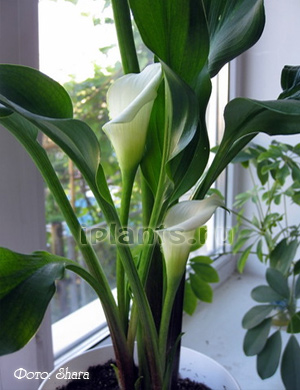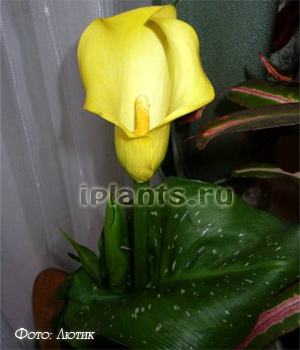Aroid family. Homeland South Africa. About 6 species of tuberous perennial herbs of the genus Zantedeskia are common in nature. And we know her under a simpler name - calla.

- Zantedeskia Ethiopian Zantedeschia aethiopica is a large bushy plant with erect stems. Leaves on long - up to 1 m petioles, heart-thyroid shape, about 30-45 cm long and 15-25 cm wide, green. When flowering, it forms several long peduncles. The inflorescence is cob, which is always shorter than the bedspread, and in some varieties is double. The cover is light green or yellow-green 15-25 cm long. Flowering occurs from January to June, after flowering berries are formed about 1 cm in diameter of yellow. Based on this species, many varieties have been bred for growing in open and closed ground. It is quite difficult to grow calli at home, because just imagine that it is necessary to create conditions like in her homeland - South Africa, and this is a lot of sun, heat and free space.
- Zantedeskia white-spotted Zantedeschia albomaculata is a large bushy plant with erect stems. Leaves on long - up to 1 m petioles, oblong-arrow-shaped, about 30-40 cm long, green on the upper side with small white spots. When flowering, it forms several long peduncles. The inflorescence is an ear, with a light yellow or white cover, having a purple color at the base, up to 10 cm long and about 5 cm wide.
- Zantedeskia Elliotta Zantedeschia elliottiana is a shorter but bushy species. Leaves on petioles up to 60 cm, wide-heart-shaped, about 20-25 cm long and 18-20 cm wide. The leaves are green, with long white dashes-spots on the upper side. The inflorescence is cob, with a cover about 15 cm long, yellow-green in color, pale yellow inside. This species differs in that it is native to the arid provinces of South Africa, so a dry and cool dormant period is required after the end of flowering of Elliot's zantedescia.
Calla care
Temperature: Grows well and blooms only when warm, at least 18C, optimum temperature 22-23C. In winter, cool wintering is required with a temperature of about 8-12 ° C, but not lower than + 4 ° C with dry content.

Lighting: Bright diffused light. Among flower growers, calla is believed to be shade-tolerant. In fact, in natural conditions, calla grows in full sun or light partial shade, so the ideal conditions will be a western or eastern window, but with additional light during daylight hours. It is believed that a long day is needed during the growth and formation of the Zantedescia peduncle - at least 12 hours. But in the future, daylight hours should be 8-10 hours.
Watering: Plentiful from spring to autumn, after the top layer of ground dries up. In winter, watering is moderate, complete drying of the land is not allowed. For irrigation, it is advisable to use soft water at room temperature or warm.
Top dressing: From the moment of growth, calla can be fed with nitrogen fertilizers, it is better to alternate between organic (rotted manure, humus or such fertilizers as "giant") and mineral (fertica lux, Agricola for flowering, Pocon, Bona Forte, etc.). Organic is needed to grow leaves and form a lush bush. Such feeding is carried out once a month - one and a half. Mineral fertilizers for flowering domestic plants contain a high proportion of phosphorus and potassium - the key to successful flowering.
Humidity: Loves very humid air, requires regular spraying and washing of leaves. You can keep the pot on a wide tray of water.
Transplant: Zantedesky requires a spacious pot of nutrient substrate. After the end of flowering in early - mid-summer, watering is reduced and feeding is stopped, gradually the leaves begin to dry out. After that, the plant is transplanted into fresh earth. Soil - 2 part of turf, 1 part of compost or humus, 1 part of sheet and 1 part of small gravel (sand, fraction of 2-3 mm). Great for hydroponic growth on nutrient substrates.
Reproduction: Division of the rhizome during transplantation.
Growing Zantedeskia in a pot
1. How to plant a calla tuber?
Gray: Zantedeskia (calla) tuber should be planted to a depth of about 5-7 cm. Pour the soil into a pot, then make a depression to the specified depth, lower the tuber there, lightly press it to the soil, then sprinkle the depression with soil without compacting it. To determine where the tuber is "up," and where the "bottom," if you get it without roots, is quite easy: you should moisten the tuber with epin solution, wrap it in a paper napkin impregnated with epin solution, and put it in a dark place for a couple of days. After this procedure, the rudiments of the roots appear and, as a rule, the rudiments of the first stem of about 3-5 mm already protrude from the tuber. It is very easy to determine.
The germination of the tuber is visible in a couple of weeks, if the tuber was completely rootless or, if there were rudiments of roots, I already germinated on the fifth day!
2. How wide should the pot be at calla?
Tamarix: The pot should be at least 15 cm in diameter. It was necessary to plant an onion (rhizome) to a depth of 10-15 cm, since the roots of hybrids grow up and grow very quickly, filling the entire pot. Therefore, if you plant calla not so deep, it will subsequently collapse. Continue to pour the earth until you understand that the flower is already enough.
3. When can calla be retired?
Gray: At home, calla can theoretically be sent to rest at any time of the year! The main thing is that the rest time is at least one and a half months. It is best to send calla to rest in early July until the end of August! Just at this time in Africa comes "winter"! Thus, you do not confuse calla with its natural rest interval. And in early September, you begin to actively wake it up (this is provided that you do not dig up a tuber). If you dig, you just plant a tuber in early September, and you wait for it to germinate. But if you do not dig out the tuber, then be sure to remove all yellowed and dead leaves somewhere in early August. Remove so that there is nothing at all on the surface of the soil. Mine, bloomed in the presence of a large number of children and did nothing!
4. How can I plant callas - they sit very close to each other in a pot. And calli are very delicate plants.
Gray: Do not be afraid to transplant if the children do not feel free to take a sharp knife and cut it off (I mean cut off and separate the root and tubers of the children, just try not to cut the tubers in half, cut between the fused tubers - there are such: fused up to five pieces together). Do not be afraid, in an adult calla with children, the root is restored very quickly. And it is necessary to transplant regularly, since calla very quickly depletes the soil, sucks all trace elements out of it.
5. Instead of the promised yellow color, the calla flower appeared green and holds like that!
Grey: On first flowering, the yellow calla (zantedeskia) does release a pale green flower, it eventually becomes pale, pale cream. Already at the second and third flowering, the color of the flower becomes bright yellow.
6. What to do with the fading calla flower, trim or wait until it wilts completely? And when to wait for the second flower?
Tamarix: Once the flowers have wilted, remove the flower stems, the foliage will still remain. Reduce watering, but keep the plant in moist ground. Towards the end of summer, further reduce watering to provoke foliage to die off, and allow the bulb to rest before the first frost.